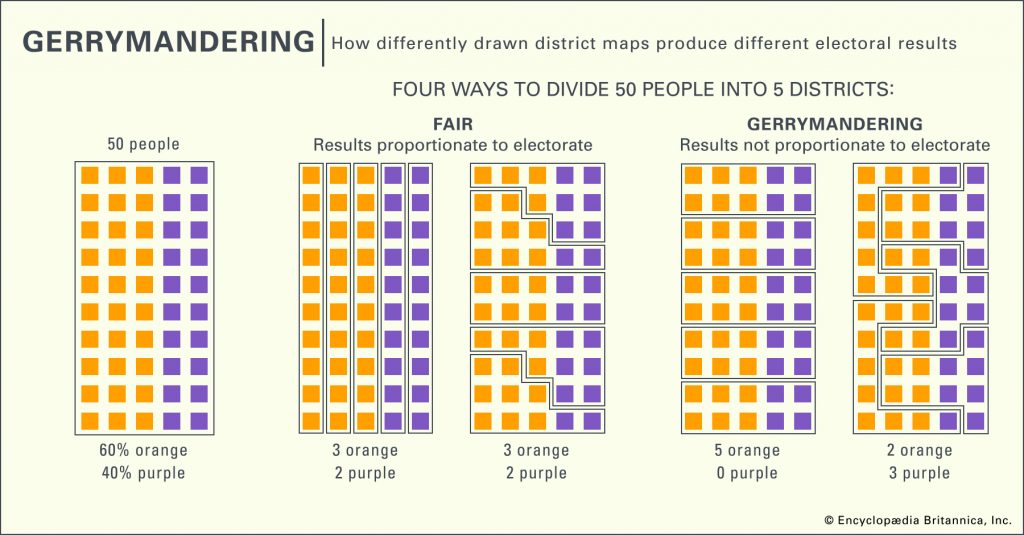American attempts to tailor district lines for political gain stretch back to the country’s very origin. Patrick Henry, who opposed the new Constitution, tried to draw district lines to deny a seat in the first Congress to James Madison, the Constitution’s primary author. Henry ensured that Madison’s district was drawn to include counties politically opposed to Madison. The attempt failed, and Madison was elected — but the American gerrymander had begun.
When one party controls the drawing of voting districts, communities are forced into groups that
> Lock up power and promote extreme partisan gain
> Eliminate incumbents, or to eliminate challengers – to the benefit of the controlling party
> Dilute minority votes
> Split communities and foster political dysfunction
Using population data from the most recent U.S. Census, the commission must draw districts with approximately the same number of people in them. Montana has used a commission to draw congressional and state legislative districts since 1973.
VISIT THE OFFICIAL WEBSITE FOR THE
MONTANA DISTRCTING AND APPORTIONMENT COMMISSION
In 2003, the Montana legislature passed a bill that attempted to influence the districting process. The state Supreme Court struck it down, saying the state constitution “assigned the task of redistricting to the Commission — an independent autonomous entity — and limited the Legislature’s role to that of making recommendations,” only after the commission releases its map.
This year, state Republican lawmakers pushed their way into the process by rushing a policy through the legislature that establishes parameters for how the district lines should be drawn.
–

Ironically, the man who inspired the term “gerrymander” served under Madison, the practice’s first American target. Just a few months before Elbridge Gerry became Madison’s vice president, as the Democratic-Republican governor of Massachusetts, Gerry signed a redistricting plan that was thought to ensure his party’s domination of the Massachusetts state senate. An editorial artist added wings, claws, and the head of a particularly fierce-looking salamander creature to the outline of one particularly notable district grouping towns in the northeast of the state; the beast was dubbed the “Gerry-mander” in the press, and the practice of changing the district lines to affect political power has kept the name ever since.
Article V, Section 14(2) of the Montana Constitution sets out the selection process for and qualifications of the commissioners.
- Commissioners are selected in the session immediately before a federal census.
- Commissioners may not be public officials.
- The majority and minority leaders of each house of the Legislature each select one commissioner.
- The first four commissioners have 20 days to select the fifth member, who will also be the commission’s presiding officer.
- The Supreme Court selects the fifth commissioner if the first four are unable to select a commissioner within the 20 days.
After results from the federal census are available, the commission must complete a congressional redistricting plan within 90 days.
The commission must present a state legislative plan to the Montana Legislature by the 10th legislative day of the first regular session after the federal census results are available. The Legislature then has 30 days to make recommendations to the commission. Within 30 days of receiving the Legislature’s recommendations, the commission must file the redistricting plan with the Secretary of State, and it becomes law. Although the commission may modify the plan to accommodate the Legislature’s recommendations, it is not required to do so.
This year: HB0506 was signed into law, and is stated as follows:
AN ACT GENERALLY REVISING ELECTION LAWS; ESTABLISHING PRIORITIES FOR DEVELOPMENT OF CONGRESSIONAL DISTRICTS; REVISING PROCEDURES FOR PROSPECTIVE ELECTORS TO REGISTER AND VOTE; CLARIFYING REQUIREMENTS FOR A BOARD OF COUNTY CANVASSERS; ELIMINATING THE EXPERIMENTAL USE OF VOTE SYSTEMS; AMENDING SECTIONS 5-1-115, 13-2-205, AND 13-15-401, MCA; REPEALING SECTION 13-17-105, MCA; AND PROVIDING EFFECTIVE DATES.
BE IT ENACTED BY THE LEGISLATURE OF THE STATE OF MONTANA:
Section 1. Section 5-1-115, MCA, is amended to read:
“5-1-115. Redistricting criteria. (1) Subject to federal law, legislative and congressional districts must be established on the basis of population.
(2) In the development of legislative districts, a plan is subject to the Voting Rights Act and must comply with the following criteria, in order of importance:
(a) The districts must be as equal as practicable, meaning to the greatest extent possible, within a plus or minus 1% relative deviation from the ideal population of a district as calculated from information provided by the federal decennial census. The relative deviation may be exceeded only when necessary to keep political subdivisions intact or to comply with the Voting Rights Act.
(b) District boundaries must coincide with the boundaries of political subdivisions of the state to the greatest extent possible. The number of counties and cities divided among more than one district must be as small as possible. When there is a choice between dividing local political subdivisions, the more populous subdivisions must be divided before the less populous, unless the boundary is drawn along a county line that passes through a city.
(c) The districts must be contiguous, meaning that the district must be in one piece. Areas that meet only at points of adjoining corners or areas separated by geographical boundaries or artificial barriers that prevent transportation within a district may not be considered contiguous.
(d) The districts must be compact, meaning that the compactness of a district is greatest when the length of the district and the width of a district are equal. A district may not have an average length greater than three times the average width unless necessary to comply with the Voting Rights Act.
(3) A district may not be drawn for the purposes of favoring a political party or an incumbent legislator or member of congress. The following data or information may not be considered in the development of a plan:
(a) addresses of incumbent legislators or members of congress;
(b) political affiliations of registered voters;
(c) partisan political voter lists; or
(d) previous election results, unless required as a remedy by a court.
(4) In the development of congressional districts and under the authority granted to the legislature by Article I, section 4, of the United States constitution, a congressional districting plan is subject to the Voting Rights Act and must comply with the following criteria, in order of importance:
(a) The districts must be as equal as practicable.
(b) District boundaries must coincide with the boundaries of political subdivisions of the state to the greatest extent possible. The number of counties and cities divided among more than one district must be as small as possible. When there is a choice between dividing local political subdivisions, the more populous subdivisions must be divided before the less populous, unless the boundary is drawn along a county line that passes through a city.
(c) The districts must be contiguous, meaning that a district must be in one piece. Areas that meet only at points of adjoining corners or areas separated by geographical boundaries or artificial barriers that prevent transportation within a district may not be considered contiguous.
(d) The districts must be compact, meaning that the compactness of a district is greatest when the length of the district and the width of a district are equal. A district may not have an average length greater than three times the average width unless necessary to comply with the Voting Rights Act.”
Section 2. Section 13-2-205, MCA, is amended to read:
“13-2-205. Procedure when prospective elector not qualified at time of registration. (1) An Subject to subsection (2), an individual who is not eligible to register because of residence or age requirements but who will be eligible on or before election day may apply for voter registration pursuant to 13-2-110 and be registered subject to verification procedures established pursuant to 13-2-109.
(2) Until the individual meets residence and age requirements, a ballot may not be issued to the individual and the individual may not cast a ballot.”
Section 3. Section 13-15-401, MCA, is amended to read:
“13-15-401. Governing body as board of county canvassers. (1) The governing body of a county or consolidated local government is ex officio a board of county canvassers and shall meet as the board of county canvassers at the usual meeting place of the governing body within 14 days after each election, at a time determined by the board, to and within 14 days after each election to complete the canvass the of returns.
(2) If one or more of the members of the governing body cannot attend the meeting, the member’s place must be filled by one or more county officers chosen by the remaining members of the governing body so that the board of county canvassers’ membership equals the membership of the governing body.
(3) The governing body of any political subdivision in the county that participated in the election may join with the governing body of the county or consolidated local government in canvassing the votes cast at the election.
(4) The election administrator is secretary of the board of county canvassers and shall keep minutes of the meeting of the board and file them in the official records of the administrator’s office.”
Section 4. Repealer. The following section of the Montana Code Annotated is repealed:
13-17-105.������� Experimental use of voting systems.
Section 5. Severability. If a part of [this act] is invalid, all valid parts that are severable from the invalid part remain in effect. If a part of [this act] is invalid in one or more of its applications, the part remains in effect in all valid applications that are severable from the invalid applications.
Section 6. Effective dates. (1) Except as provided in subsection (2), [this act] is effective October 1, 2021.
(2) [Sections 1 and 5] and this section are effective on passage and approval.
